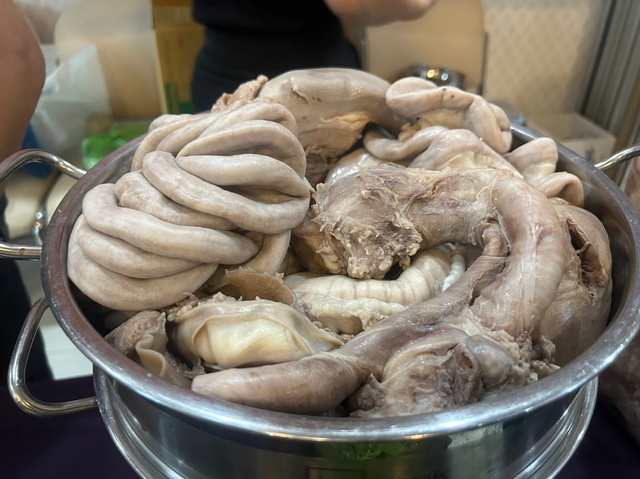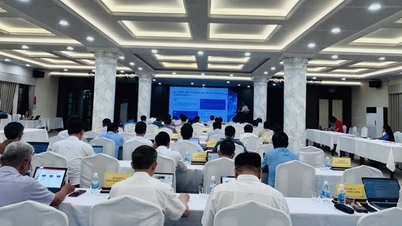What is the difference between the pipe core?
Doctor Nguyen Huy Hoang, Vietnam - Russia High Pressure Oxygen Center, Ministry of National Defense , said that the pig intestine is a short section of the small intestine, characterized by thick intestinal walls, many sinewy folds, creating a chewy, sweet and not greasy feeling when eaten.
The name “se dieu” comes from its round, sturdy shape, resembling a traditional tobacco pipe. The best part is located near the stomach, with a thin layer of fat covering the inside, providing a unique culinary experience.
Compared with the normal pig intestine, the intestine of the hookah has a firm texture, good elasticity, does not shrink much when boiled or steamed and keeps a beautiful white color. These characteristics not only create sensory differences but also imply a special physiological structure, which may be related to the development of local hypertrophy of intestinal tissue.
The dish of grilled intestines is widely advertised on social networking sites.
SCREENSHOT
The intestines are often thought to appear in old, weak sows, raised for many years on a household basis, with a natural diet of vegetables and duckweed. According to experts, this is not a product of sick pigs, but a rare characteristic of native pigs or sows.
In contrast, industrial pigs, with short rearing time and standardized feed, have almost no intestines.
However, this scarcity contradicts the market reality, where pipe hearts are commonly sold, especially on social networks, for 1-4 million VND/kg. This makes many people in the profession question the counterfeit goods, using chemicals such as hydrogen peroxide, alum, and even formalin to "magically" turn normal hearts into pipe hearts, causing serious health risks.
Is pipe intestine more nutritious than regular pig intestine?
According to Dr. Hoang, there is currently no scientific research confirming that the intestines of the pig have superior nutritional value compared to the normal intestines. In general, pig intestines provide 100-150 kcal, 7.2-22 g of protein, 1.3 g of fat and micronutrients such as iron, zinc, vitamin B12 per 100 g. However, the high cholesterol content (nearly 400 mg/100 g) requires moderate consumption, especially for people with cardiovascular or metabolic diseases.
The “superiority” of real pipe heart lies primarily in texture and flavor, not nutritional content. Its high price and scarcity create a bias that it is “more nutritious,” but there is no scientific evidence to support it.
Dr. Hoang said that the unusual popularity of pipe intestines on the market, contrary to their natural rarity, shows the risk of commercial fraud. Counterfeit products, soaked in toxic chemicals, not only deceive consumers but also pose the risk of poisoning, digestive damage, and even cancer if accumulated over a long period of time. Distinguishing between real and fake by sensory means is extremely difficult, even with characteristics such as elasticity, color or texture.
"In addition, pig organs pose a risk of bacterial and parasitic contamination if not cleaned and cooked thoroughly. Consumers need to prioritize reputable sources and avoid floating products, especially on uncontrolled online platforms," Dr. Hoang noted.
Common pig offal dish
PHOTO: Le Cam
Notes when eating pipe intestines
Dr. Hoang recommends that consumers should consider pork intestines as a unique dish in terms of flavor, not expecting superior nutritional benefits. Limit regular consumption because pork intestines contain high cholesterol. At the same time, be wary of counterfeit goods, be suspicious of products with too high prices or mass advertising. Prioritize buying pork intestines from reputable slaughterhouses and sellers. Prepare carefully and cook completely to eliminate the risk of bacterial and parasitic infections.
In cases of suspicion or detection of counterfeit goods, it is necessary to report to the authorities to check, trace the origin and strictly handle fraud to protect public health.
"The intestines of a pipe are an attractive delicacy thanks to their unique texture and flavor, but their nutritional value is not superior to that of regular intestines. Their natural scarcity is exaggerated by marketing tricks, leading to the risk of counterfeit goods and toxic chemicals. Consumers need to take a smart approach, prioritize food safety, and demand transparency from suppliers. Regulatory agencies need to step in to ensure that the intestines of a pipe are not only delicious, but also a safe choice for health," Dr. Hoang advised.
Source: https://thanhnien.vn/long-se-dieu-co-bo-duong-hon-long-heo-non-thong-thuong-185250507124116373.htm





![[Photo] Ready for the 2025 Fall Fair](https://vphoto.vietnam.vn/thumb/1200x675/vietnam/resource/IMAGE/2025/10/14/1760456672454_ndo_br_chi-9796-jpg.webp)

































































































Comment (0)